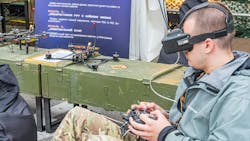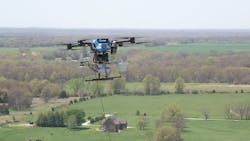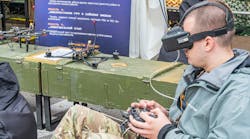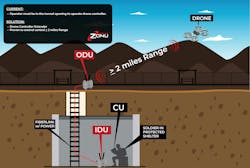Revolutionizing Drone Communications with RF over Fiber
The strategic landscape of modern warfare and critical infrastructure monitoring has undergone a dramatic transformation, with unmanned aerial vehicles (UAVs), or drones, as they’re commonly known, playing a central role. Nowhere is this shift more visible than in the ongoing conflict in Ukraine, where low-cost drones are being mass produced and deployed at scale.
These devices are no longer confined to reconnaissance. They’re pivotal in both offensive and defensive operations, whether surveillance, tactical strikes, or communication support.
Outside the battlefield, drones have become vital tools in a wide array of enterprise applications. Utility providers now employ drones for monitoring above-ground infrastructure like gas pipelines and power lines. At sensitive sites, such as nuclear facilities, drones offer a safe and efficient means of inspection that minimizes human exposure to hazardous environments.
As reliance on drones grows in military and commercial applications, so too does the need for secure, reliable, and interference-free long-distance communication. Traditional wireless RF methods of controlling drones — utilizing frequency bands reserved for Wi-Fi or public-safety networks leveraging — are prone to signal degradation, jamming, and interception. RF over fiber (RFoF) is quickly becoming an important means of providing high-bandwidth and highly reliable communication technology in drone operations to offset these challenges.
RFoF Unlocks New Drone Control Possibilities
RFoF technology takes RF, converts it to light waves, and then reconverts it back to RF at its destination with high dynamic range, providing bidirectional communication from a drone to its controller and vice versa. It’s already finding traction across multiple deployment models, enabling novel capabilities that address the shortcomings of conventional communication systems.
One common application is tethered drone control. In this model, a stationary drone is connected to a ground-based controller via a reusable fiber drum. This setup allows the drone to remain airborne for extended periods. The drone effectively acts as an aerial relay, raising antennas to improve communication in difficult terrain. Such a technique is already being explored by mobile carriers like AT&T (Fig. 1) for emergency response scenarios.
RFoF is also being explored for inexpensive, single-use, suicide drone missions in military combat. Here, the fiber drum is mounted directly on the drone, feeding out as the drone progresses toward its target holding a small explosive. This method ensures a secure and interference-free communication link all the way up to the point of impact.
While the drone isn’t recoverable, the expense is justified because it’s targeting more expensive enemy equipment. The fiber link’s immunity to jamming ensures that the drone reaches its objective without external disruption.
>>Download the PDF of this article, and check out the TechXchange for similar types of articles and videos
Another flexible use case is the controller extender model, which can be applied to any drone platform. In this setup, the fiber connects the controller to a remote terminal called an indoor unit (IDU), which is run via fiber to an outdoor unit (ODU), thus extending its wireless operational range without requiring a direct physical link to the drone itself.
Both IDUs and ODUs are utilized to protect the individual from elements (Fig. 2) and give drones extended access in hard-to-reach areas. In this example, the IDU and ODU are reusable, and rapidly deployable systems can be placed in temporary, ad hoc locations and moved at a moment’s notice.
This approach is also particularly valuable in complex environments such as mining operations, nuclear waste handling, and battlefield conditions where a more permanent solution is needed. If a military unit is trying to conduct reconnaissance underground through a tunnel (Fig. 3) using drone technology, the extender allows them to do so over long distances.
Why RFoF is an Ideal Modality for Drone Communication
Of course, there are other communication technologies to fly drones remotely, but most tend to have drawbacks that RFoF simply don’t face. One of the key strengths of RFoF is its immunity to interference and jamming.
Because RFoF transmits signals as light through fiber-optic cables, it’s virtually unaffected by electromagnetic interference, intentional jamming, or signal eavesdropping. This makes it a secure and robust solution in environments where signal integrity is critical, which describes nearly every use case for drones in military or critical infrastructure applications.
Other significant benefits of RFoF are its low jitter, high dynamic range, and high bandwidth. The technology delivers signals with minimal distortion and extremely low latency, making it particularly well-suited for mission-critical applications such as high-resolution video surveillance, radar systems, and direct sequence spread spectrum (DSSS). DSSS is a spread-spectrum modulation technique that extends the bandwidth of a transmitted signal to reduce interference and enhance signal robustness.
In terms of physical performance, RFoF systems are lightweight and power-efficient. Because such systems require minimal onboard electronics, drones benefit from a reduced payload burden. This directly contributes to longer flight durations and improved overall performance, which is especially valuable for both commercial and defense applications.
RFoF as a Transformative Enabler in UAV Applications
As drone operations continue to expand across both military and commercial domains, the demand for robust, secure, and interference-resistant communication systems is more critical than ever. RFoF stands out as a transformative enabler in this space, offering unmatched signal integrity, low latency, and adaptability across a range of deployment models.
Whether enhancing tactical operations on the battlefield or improving infrastructure monitoring in remote environments, RFoF provides the reliability and scalability needed to support the next generation of unmanned aerial systems.
>>Download the PDF of this article, and check out the TechXchange for similar types of articles and videos
About the Author
Farzad Ghadooshahy
Co-Founder and CTO, Optical Zonu
Farzad Ghadooshahy has over 40 years of experience in research and product development in fiber-optic and RF/microwave technologies. He has been instrumental in driving innovation at Optical Zonu and has played a pivotal role in developing advanced optical-fiber transceiver modules and designing system-level products that form the backbone of the company’s offerings.





